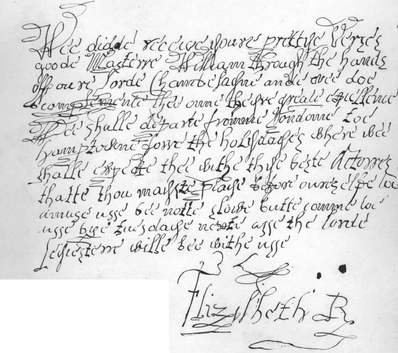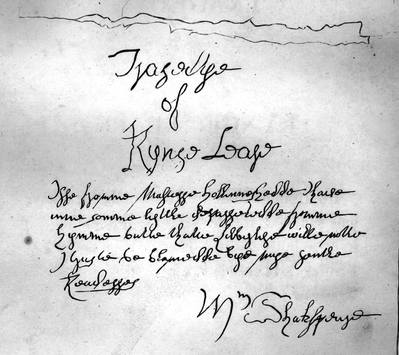Contested Will (4 page)
Authors: James Shapiro

Among the discoveries were a letter to and another from the Earl of Southampton, to whom Shakespeare had dedicated both
Venus and Adonis
and
The Rape of Lucrece
, as well as a note from Queen Elizabeth, signed in her unmistakable hand, thanking
Shakespeare for the âpretty verses' he had sent her and informing him that âWe shall depart from London to Hampton for the holidays where we shall expect thee with thy best actors that thou mayest play before ourself to amuse us.'

Letter from Queen Elizabeth, from Samuel Ireland,
Miscellaneous Papers
Biographies of Shakespeare would have to be updated and revised. As a column in the newspaper
The Oracle
announcing these remarkable finds made clear, this royal letter in particular showed that previous, anecdotal accounts of Shakespeare's start in the theatre were âdegrading nonsense' and âutterly fictitious'. The papers revealed a different aspect, a ânew character' of Shakespeare's, one that combined âan acute and penetrating judgment with a disposition amiable and gentle as his genius was transcendent'.
London's leading men of letters descended on the Ireland household on Norfolk Street, eager to view and verify these extraordinary papers. Among the first were two men knowledgeable in matters
Shakespearean: the literary critic Joseph Warton and the classics scholar Samuel Parr, who were especially impressed by Shakespeare's âProfession of Faith': âOur litany abounds with beauties, but here is a man has distanced us all,' and they, as well as others, congratulated young William-Henry on having afforded âso much gratification to the literary world'.
An even greater discovery emerged in early February 1795, when William-Henry Ireland's further searches turned up a long-lost manuscript of
King Lear
. The invaluable find confirmed what editors and critics had suspected: Shakespeare's original had been carelessly treated in the playhouse; the printed editions were littered with actors' cuts, interpolations and scurrility. By comparing the manuscript (or transcripts of its now difficult to decipher secretary hand) with printed versions of Lear's final speeches, critics were able to see the great difference between what Shakespeare had originally written:

Manuscript page of
King Lear
, from Samuel Ireland,
Miscellaneous Papers
What is't thou sayst? Her voice was ever soft
And low, sweet music o'er the rippling stream,
Quality rare and excellent in woman.
O yes, by Heavens, 'twas I killed the slave
That did round thy soft neck the murderous
And damned cord entwine. Did I not, sirrah?
and what the actors had done to these lines, as evident in the butchered version that appeared in the edition of the play printed in 1608:
What is't thou sayst? Her voice was ever soft,
Gentle and low, an excellent thing in woman.
I killed the slave that was a-hanging thee.
The excessive cuts made clear why in his 1611 âDeed of Trust' Shakespeare requested that if his plays âbe ever again imprinted', it should be done from his manuscripts and not from the corrupt versions ânow printed'. No less important for understanding the author's intentions was a note on the first page of the
Lear
manuscript, which underscored that Shakespeare wrote not only for the stage but also, if not primarily, for his âgentle readers'.
The excitement in London's literary community was justifiably great. James Boswell, famous for his
Life of Johnson
, perused the manuscripts and documents in mid-February, then kissed them, kneeled, and declared, âHow happy am I to have lived to the present day of discovery of this glorious treasure. I shall now die in peace.' Boswell went to his grave three months later, having lived to see and hold the manuscript of Shakespeare's great tragedy. The playwright and biographer James Boaden recalled his own excitement: âI remember that I beheld the papers with the tremor of purest delight â touched the invaluable relics with reverential respect, and deemed even existence dearer, as it gave me so refined a satisfaction.' The press to view the Shakespeare papers was so great that two weeks after Boswell's celebrated visit, Samuel Ireland had to restrict access and even charge an entry fee of two guineas: âAny gentleman, on sending his address in writing, on
being introduced by a subscriber, may view the manuscripts at Number 8, Norfolk Street, on Monday, Wednesday, and Fridays, between the hours of twelve and three.' The Prince of Wales â the future King George IV â invited Samuel Ireland to Carleton House to show him Shakespeare's papers in person. Britain's newspapers and magazines were filled with stories about the discoveries.
Samuel Ireland decided to make transcriptions and even some facsimiles of the papers available in a sumptuous volume, and leading scholars, heralds, dramatists and men of taste testified to their conviction that âthese papers can be no other than the production of Shakespeare himself'. The
Miscellaneous Papers
appeared in print right before Christmas 1795, prefaced by a list of over a hundred prominent subscribers. Contemporaries would have noted, perhaps with a smile, the absence of two names from these lists, the greatest living authorities on Shakespeare's life and work: Edmond Malone and George Steevens. Malone must have been jealous; despite his intense interest in documents in Shakespeare's hand, he had not even deigned to visit the house on Norfolk Street to view the papers. Steevens, too, had not gone to see them, though his reticence may have been more understandable. While his reputation was built upon editing Shakespeare's plays, it had been sullied by his attempt to defraud the public with a forged letter from the Elizabethan playwright George Peele to Christopher Marlowe, a transcription of which he published in the
Theatrical Review
(Steevens had Peele describe how the actor Edward Alleyn teased Shakespeare about borrowing his words in the scene in which Hamlet advises the players).
Shortly after the
Miscellaneous Papers
were published, a tantalising report of new and even more exciting material came to light. William-Henry Ireland informed a committee of twenty-four authorities convened by his father that he had learned of additional finds, including whole or partial manuscripts of
Julius Caesar
and
Richard the Second
, as well as of a hitherto unknown Shakespeare play,
Henry the Second
. A manuscript of another
Shakespearean history,
Vortigern
â drawn from Holinshed's
Chronicles
, on the tumultuous life of Vortigern, the fifth-century ruler of the Britons who fell in love with the Saxon princess Rowena â had also been discovered. The script of
Vortigern
appeared promising enough to restage; a four-hundred-line excerpt circulated and negotiations were begun with the managers of Drury Lane and Covent Garden theatres, both of whom were eager to present the long-lost play. A catalogue of books in Shakespeare's own hand had also been found, along with his annotated copies of Chaucer's
Works
, Holinshed's
Chronicles
and the Bible, a âdeed by which he became partner of the Curtain Theatre', two drawings of the Globe, verses to Elizabeth I, Sir Francis Drake and Walter Ralegh, along with the most tantalising discovery of all: Shakespeare's âbrief account of his life in his own hand'.Â
*
It was all a fraud. William-Henry Ireland would eventually confess to having forged every single document (including the old drawing of a young Jacobean man, reproduced at the beginning of this chapter, that he had purchased on Butcher Row and doctored to resemble Shakespeare). The mysterious âMr H.' didn't exist. Reports of finding other lost plays or Shakespeare's memoirs were pure fantasy. So too were additional forgeries, including one in which Shakespeare thanks a fellow Elizabethan (coincidentally named William Henry Ireland) for saving him from drowning in the Thames. The remnants of Shakespeare's library, with its forged catalogue listing over a thousand volumes, consisted of rare books that William-Henry found in London's bookstalls and then inscribed with Shakespeare's signature and annotations. To produce authentic-looking documents he purchased bookbinder's ink that looked old and faded, then filched paper and ancient seals from his law office. The random choice of a seal displaying a quintain (hinting at Shakespeare's name) was a happy accident. When he ran out of paper he obtained more from London booksellers who sold him blank endpapers torn out of rare books. His rendering of Shakespeare's signature proved convincing because he had
traced it from a version that had recently appeared in facsimile in Malone's edition of Shakespeare's works. William-Henry, barely out of his teens, had done it all without an accomplice, and with incredible speed. He had deceived nearly everyone in literary London, including his own father.
His labours sparked what might be called the first Shakespeare authorship controversy, an instructive episode that ought to be better known, for it introduced a set of arguments familiar to anyone acquainted with subsequent disputes over who wrote Shakespeare's plays. Mortified contemporaries should have known better, even as the Irelands themselves should not have fallen for the cock-and-bull story that Mr and Mrs Williams of Clopton House â toying with the expectations of tourists hunting for curios â told them about having recently burned Shakespeare's papers. One reason why the
Miscellaneous Papers
succeeded in duping so many is because the collection read like a documentary life, one that refracted the profile of Shakespeare through the expectations of the time. The good husband, loyal subject, devout Protestant and all-round contemporary man of letters perfectly matched what people hoped to discover about Shakespeare, and established a precedent for future claims about the identity of the author of the plays, which would turn out to be no less grounded in fantasy, anachronism and projection.
Ireland's most notorious attempt at passing his own words off as Shakespeare's â the chronicle history of
Vortigern
â was performed on the London stage on 2 April 1795, on the eve of the exposure of the forgeries. It was a disaster. The most humiliating moment for the Irelands may well have been the ten-minute uproar, much of it consisting of raucous laughter, that followed John Philip Kemble's pointed delivery of the unfortunate line, âAnd when this solemn mockery is ended'. Had the Irelands held off on seeing it staged and refrained from publishing âShakespeare's papers', the controversy over the documents' authenticity would likely have gone on for years.
William-Henry undertook these forgeries not long after the author of
Hamlet
and
Lear
had begun to be regarded as a literary deity, a crucial precondition for this and all subsequent controversies over his identity. It also helps explain why Drury Lane had won out over Covent Garden for the right to stage
Vortigern
, given how heavily invested that playhouse had been in promoting a divine Shakespeare. In April 1794, the newly rebuilt Drury Lane had been rededicated as a âmonument' to Shakespeare, a âshrine more worthy of his fame we give, / Where unimpaired, his genius still may live'. The opening-night performance of
Macbeth
concluded with an epilogue spoken by the popular actor Elizabeth Farren, who called for the âGenius of Shakespeare' roaming in the air to spread his âbroad wings' over their ânew reared stage'. As a larger-than-life sculpture of Shakespeare was revealed onstage, Farren proclaimed:
And now the image of our Shakespeare view
And give the Drama's God the honour due.
This divine image of Shakespeare was surrounded by a group of his literary creations along with the Muses of Comedy and Tragedy, and the performers onstage burst into song:
Behold this fair goblet, 'twas carved from the tree,
Which, O my sweet Shakespeare, was planted by thee;
As a relic I kiss it, and bow at the shrine,
What comes from thy hand must be ever divine!
All shall yield to the mulberry-tree.
Bend to thee,
Blest mulberry,
Matchless was he
Who planted thee,
And thou like him immortal be.
